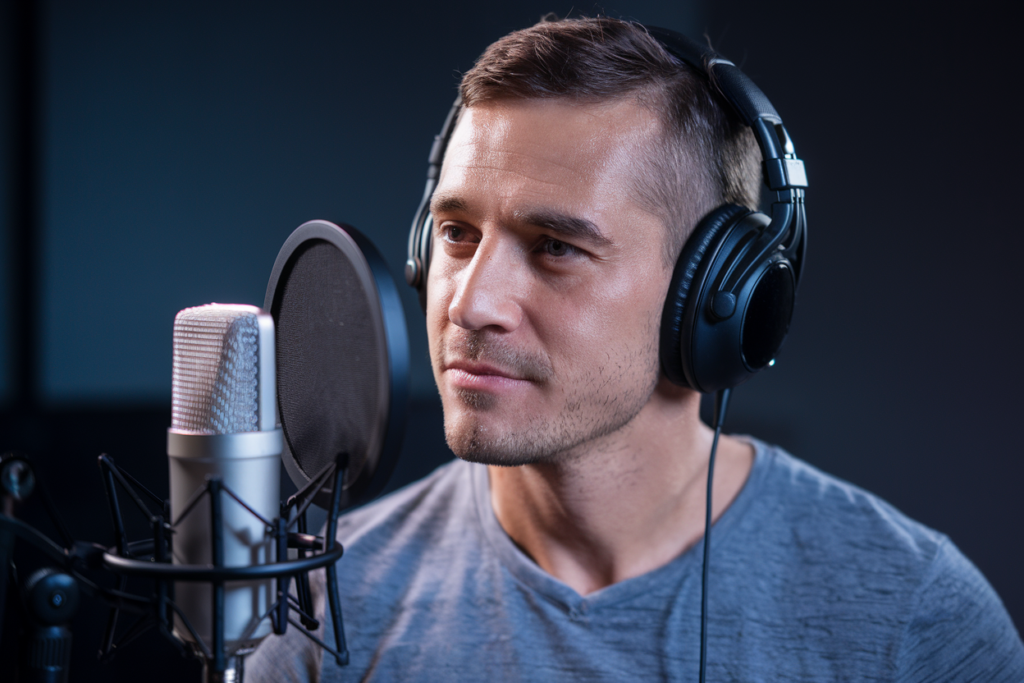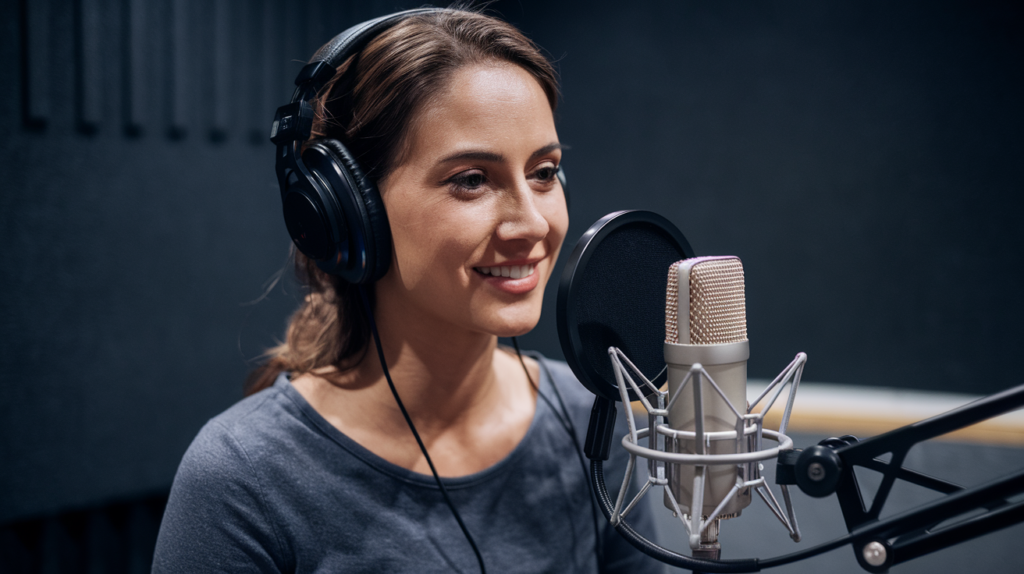Key Takeaways
- Dubbing Workflow Overview: The Romanian dubbing process consists of script adaptation, casting voice talent, recording, post-production, and quality assurance to create engaging content for local audiences.
- Script Translation and Adaptation: Accurate translation is crucial; it requires cultural sensitivity to ensure the dialogue resonates with Romanian viewers while maintaining character voices and emotional nuances.
- Importance of Voice Casting: Selecting skilled voice actors who can authentically convey emotions enhances the viewing experience, making character portrayals relatable and engaging for audiences.
- Recording Phase Essentials: High-quality studio setups with professional equipment are vital. Direction during recording helps capture the necessary emotion and timing in performances.
- Post-Production Refinement: Editing and mixing are key steps that transform recordings into polished audio. Quality control ensures the final product meets high standards before release.
- Challenges Faced in Dubbing: Unique difficulties include script adaptation complexities, finding suitable voice talent, technical recording constraints, effective direction during sessions, and thorough post-production adjustments.
Ever wondered how your favorite movies and shows get that perfect Romanian voiceover? The dubbing workflow for the Romanian language is a fascinating blend of art and technology, designed to bring stories to life in a way that resonates with local audiences.
Overview of Dubbing Workflow
Dubbing involves several crucial steps that transform original audio into engaging content for Romanian audiences. This workflow begins with script adaptation, where the source material is translated and culturally tailored to resonate with local viewers. It’s essential that the dialogue flows naturally in Romanian while preserving the original tone and intent.
Next, casting voice talent plays a critical role. Selecting skilled voice artists who can convey emotions effectively enhances the viewing experience. You want voice actors who not only match character profiles but also possess versatility to adapt their performances as needed.
Once casting is complete, recording sessions take place in a professional studio. Here, voiceover artists deliver their lines while syncing with on-screen action. High-quality equipment ensures clarity and fidelity, capturing every nuance of their performance.
Post-production follows recording, where editing teams refine audio tracks. They adjust sound levels and eliminate any background noise or errors. This step guarantees a polished final product that aligns seamlessly with visuals.
Finally, quality assurance checks ensure everything meets high standards before release. Language experts review the dubbed content for accuracy and cultural relevance, ensuring it resonates well with your audience.
This structured approach creates compelling dubbing that not only entertains but also connects deeply with viewers in Romania.
Key Components of Dubbing Workflow
A successful dubbing workflow hinges on several essential components that ensure the final product resonates with Romanian audiences. Each step contributes to creating high-quality voiceovers that engage viewers effectively.
Script Translation and Adaptation
Script translation and adaptation serve as the foundation for the entire dubbing process. You start by translating dialogue from the source material into Romanian, ensuring not just accuracy but also cultural relevance. This means adapting idioms, jokes, and references so they align with local sensibilities. A good script adaptation captures the original tone while making it relatable for viewers in Romania.
Additionally, maintaining character voices is vital; each character’s personality should shine through in their lines. Effective translators often collaborate closely with directors to preserve emotional nuances, enhancing the overall viewing experience.
Voice Casting Process
The voice casting process plays a critical role in bringing characters to life through skilled voice talent. Selecting appropriate voiceover artists involves evaluating their range and ability to convey emotions authentically. You want actors who can match character profiles perfectly—this connection helps immerse audiences in the story.
Auditions typically showcase potential candidates reading lines from the script, allowing you to assess how well they embody specific roles. This careful selection ensures that every performance feels genuine and aligns with audience expectations for quality dubbing.
By prioritizing these components—script translation and voice casting—you set the stage for a successful dubbing project that truly resonates with viewers in Romania.
Recording Phase
The recording phase is where the magic happens. It’s the moment when voice talents bring characters to life, creating an immersive experience for the audience.
Studio Setup and Equipment
Setting up a professional studio is essential for achieving high-quality recordings. You’ll want to ensure you have soundproofing materials in place to minimize external noise. Using quality microphones—like condenser or dynamic types—captures every nuance of the performance. A digital audio workstation (DAW) should be part of your setup; it allows for seamless recording and editing. Additionally, incorporating headphones helps voice artists monitor their performance accurately without feedback issues.
Direction and Performance Techniques
Direction during recording plays a vital role in shaping performances. Directors guide voice actors by providing clear instructions on emotion, timing, and delivery style. This collaboration ensures that every line resonates with authenticity. Utilizing techniques like cold reads or rehearsals can help voice talent settle into their roles before final takes are recorded. Encouraging improvisation may also lead to unexpected gems that enhance character depth, making the final product even more engaging for viewers.
By focusing on these elements during the recording phase, you set a solid foundation for successful Romanian dubbing projects that connect with local audiences effectively.
Post-Production Process
The post-production process is vital for ensuring the delivered product meets high standards and resonates with the target audience. It involves several key steps that refine the initial recordings into polished voiceovers ready for distribution.
Editing and Mixing
Editing and mixing transform raw audio recordings into a cohesive final product. You’ll want to remove any mistakes, unwanted sounds, or background noise from the tracks recorded by voice actors. This step often includes adjusting levels to ensure consistent volume throughout. Mixing involves blending multiple audio elements—such as sound effects or music—with your voiceover talent’s performance, creating an immersive experience. The goal here is clarity; you want every word spoken by the voice artist to be crisp and clear, enhancing viewer engagement.
Quality Control and Finalization
Quality control ensures that each voiceover meets established standards before release. This stage typically involves listening sessions where various stakeholders review the edited tracks for accuracy in tone, emotion, and timing. Any necessary adjustments are made based on feedback from directors or producers who understand how critical these elements are in captivating an audience.
Finalization wraps up this meticulous process by preparing files for different formats required by distribution channels. Whether it’s television, streaming services, or other media platforms, you’ll want to ensure that all technical specifications align perfectly with industry standards.
By following these detailed steps during post-production, you can enhance your project’s overall quality while maintaining cultural relevance tailored specifically for Romanian audiences.
Challenges in Dubbing Workflow for Romanian Language
Dubbing for the Romanian language comes with unique challenges that impact the overall workflow. Understanding these obstacles helps in creating a seamless experience for both voice talents and audiences.
Script Adaptation Difficulties
Adapting scripts isn’t just about direct translation; it requires cultural sensitivity. Idioms, humor, or references that resonate with one audience might confuse another. Ensuring that the script feels natural while staying true to the source material poses a significant challenge.
Casting Voice Talent
Finding the right voice talent is crucial yet complex. Not every voice artist can embody specific characters authentically. Evaluating emotional range and compatibility with character profiles demands careful consideration during casting sessions.
Recording Constraints
Technical limitations during recording sessions can hinder performance quality. Inadequate studio conditions or subpar equipment may affect how well voice actors deliver their lines. A professional environment is essential for achieving optimal audio quality and clarity.
Direction During Recording
Directing voice over talent effectively presents its own set of challenges. Communicating specific emotions or timing nuances requires strong collaboration between directors and artists. Misunderstandings can lead to performances that miss the mark, impacting the final product’s authenticity.
Post-Production Adjustments
The post-production phase involves refining raw recordings, which often reveals additional hurdles. Balancing voiceovers with sound effects or music needs precision; any imbalance could distract from the story being told. Quality control checks must be thorough to guarantee accuracy in tone and emotion throughout.
Navigating these challenges demands expertise, patience, and creativity from everyone involved in the dubbing process. Each step plays a critical role in delivering an engaging experience for Romanian audiences who deserve nothing less than exceptional storytelling through carefully crafted voiceovers.
Conclusion
Mastering the dubbing workflow for the Romanian language is essential in creating engaging content that resonates with local audiences. Each step from script adaptation to post-production plays a significant role in ensuring authenticity and emotional connection. By navigating challenges like cultural sensitivity in translation and effective voice casting, you can enhance the overall quality of your projects.
Investing time and resources into this process not only enriches storytelling but also builds trust with viewers who seek relatable experiences. Ultimately, embracing these intricacies will lead to successful voiceovers that truly bring stories to life for Romanian audiences. Your dedication to excellence will make all the difference in delivering captivating narratives through expertly crafted dubbing.
Frequently Asked Questions
What is the process of Romanian voiceovers in movies and shows?
The process involves several steps, starting with script adaptation, where the original material is translated and culturally tailored. Next, skilled voice talent is cast to match character profiles, followed by recording sessions in professional studios to sync voices with on-screen action. Finally, post-production ensures high-quality audio through editing and mixing.
Why is script adaptation important for Romanian voiceovers?
Script adaptation is crucial because it ensures that cultural nuances, idioms, and humor resonate with Romanian audiences. A well-adapted script makes the content relatable and engaging, enhancing viewer experience.
How do they select voice talent for Romanian dubbing?
Selecting voice talent involves assessing actors’ ability to convey emotions authentically while matching character profiles. Not every artist can embody specific characters convincingly; thus, careful casting is essential for quality results.
What challenges arise during recording sessions for Romanian voiceovers?
Recording sessions can face technical constraints that impact performance quality. Additionally, creating a professional environment is vital for allowing artists to deliver their best work while syncing their performances with visuals.
How does post-production affect the final product of Romanian voiceovers?
Post-production plays a key role by refining raw recordings through editing and mixing. This phase balances voiceovers with sound effects or music to ensure clarity and enhances overall storytelling quality before release.
What role does directing play in achieving effective Romanian voiceovers?
Directing is critical as it helps communicate emotional nuances and timing required from voiceover talent. Effective direction guides artists toward authentic performances that resonate well with local audiences.
How do quality control checks ensure successful dubbing in Romania?
Quality control checks involve reviewing tone accuracy, emotion delivery, and timing consistency throughout the dubbing process. Feedback from directors or producers allows necessary adjustments to be made before finalizing the product for audiences.







